

Salmon with Asparagus, Three Ways
Broiled Salmon with Coconut Sauce and Avocado Purée
Salmon en Croute with Minted Peas and Hollandaise
Arctic Char and Rice Noodles in Curry Broth
Salt-Baked Branzino and Roasted Baby Vegetables
Miso Black Cod in Coconut-Ginger Broth
Vadouvan-Spiced Monkfish with Pancetta Lentils
Thai Prawn Curry with Prawn Dumplings
Soy-Marinated Yellowtail with Sautéed Green Beans and Mushrooms
Seared Scallops with Jalapeño-Poblano Salsa
Alligator Stir-Fry with Grilled Pineapple
SALMON WITH ASPARAGUS, THREE WAYS


This dish looks beautiful and complicated, but it is even more impressive when you consider how few actual ingredients there are. Abby was able to prepare an elegant main course using essentially only two ingredients: salmon and asparagus. She even transformed the asparagus and the water it was cooked in into a simple yet flavorful sauce! Sometimes a little ingenuity is the key ingredient.
serves 4
Kosher salt
48 asparagus stalks, trimmed
5 tablespoons olive oil, plus more for brushing
Freshly ground black pepper
4 (5-ounce) skin-on salmon fillets
BROILED SALMON
with COCONUT SAUCE and AVOCADO PURÉE
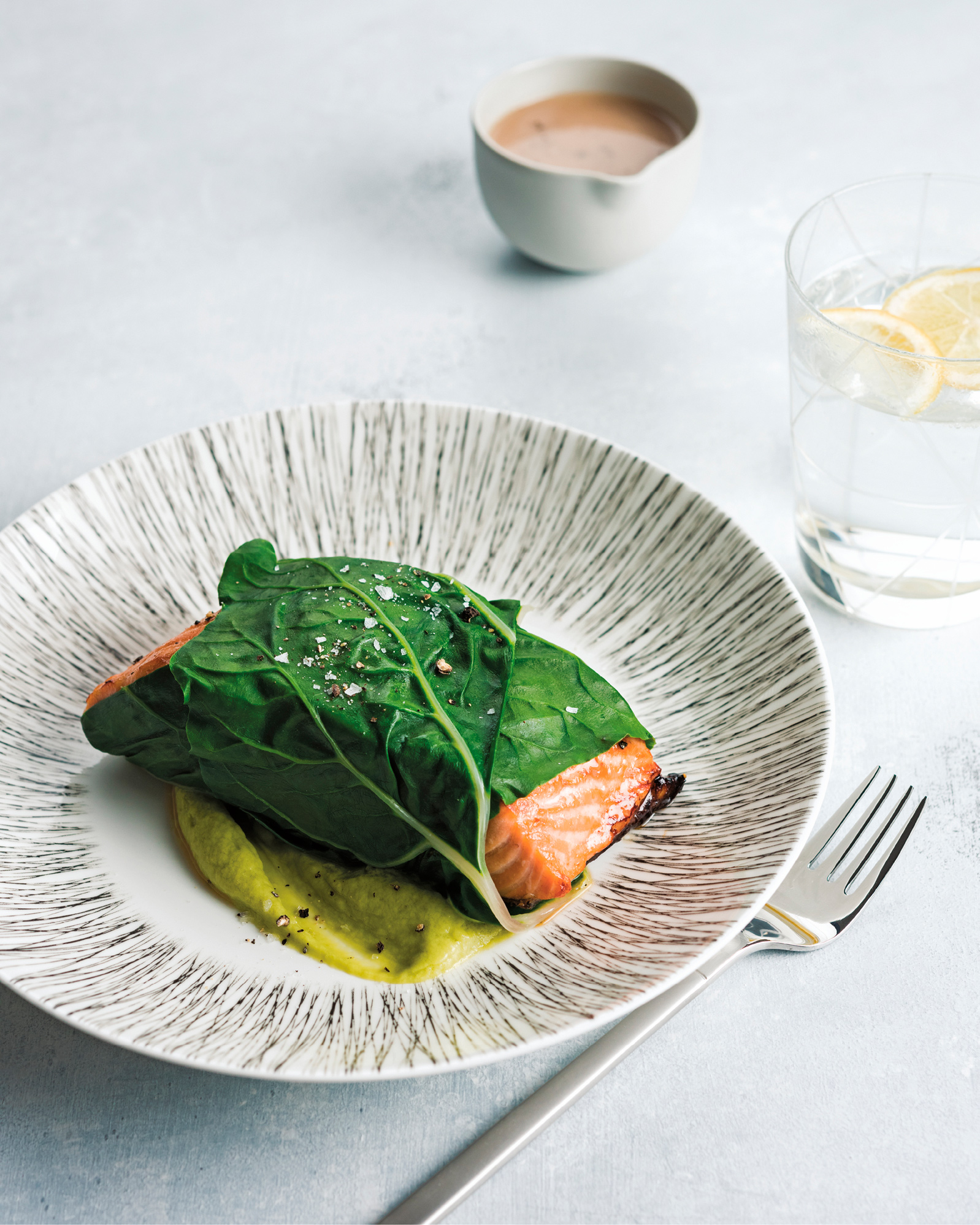

While the method of cooking this salmon is relatively simple, the other parts of this dish are not. There’s a savory coconut sauce that’s thick and creamy and a smooth avocado purée. Plus, Jack served Sautéed Broccolini (this page) and thin slices of mango on the side. All together, these various components make for what the judges called “an artistic, imaginative” dish. You could, of course, choose to serve just the recipe here, but if you really want to impress your guests the way Jack impressed the judges, then gather all the ingredients and get cooking!
serves 4
Coconut Sauce
1 (15-ounce) can unsweetened coconut milk
2 tablespoons fresh lime juice
1 shallot, finely chopped
2 tablespoons sugar
2 garlic cloves, finely chopped
1 tablespoon soy sauce
Kosher salt and freshly ground black pepper
Avocado Purée
2 ripe avocados, pitted and peeled
2 tablespoons mascarpone cheese
Juice of 1 lemon
2 teaspoons kosher salt
Salmon
¼ cup soy sauce
¼ cup fish stock
2 tablespoons honey
4 skin-on salmon fillets, about 4 ounces each
Kosher salt and freshly ground black pepper
4 large Swiss chard leaves, blanched (see Tip) and stemmed
TIP Blanching means boiling something briefly, then transferring it to a bowl of ice water to stop the cooking. This method helps to preserve the vibrant color of a vegetable. Swiss chard leaves need to cook for only a few minutes, though other vegetables, like asparagus, need to cook a little longer.
SALMON EN CROUTE
with MINTED PEAS and HOLLANDAISE
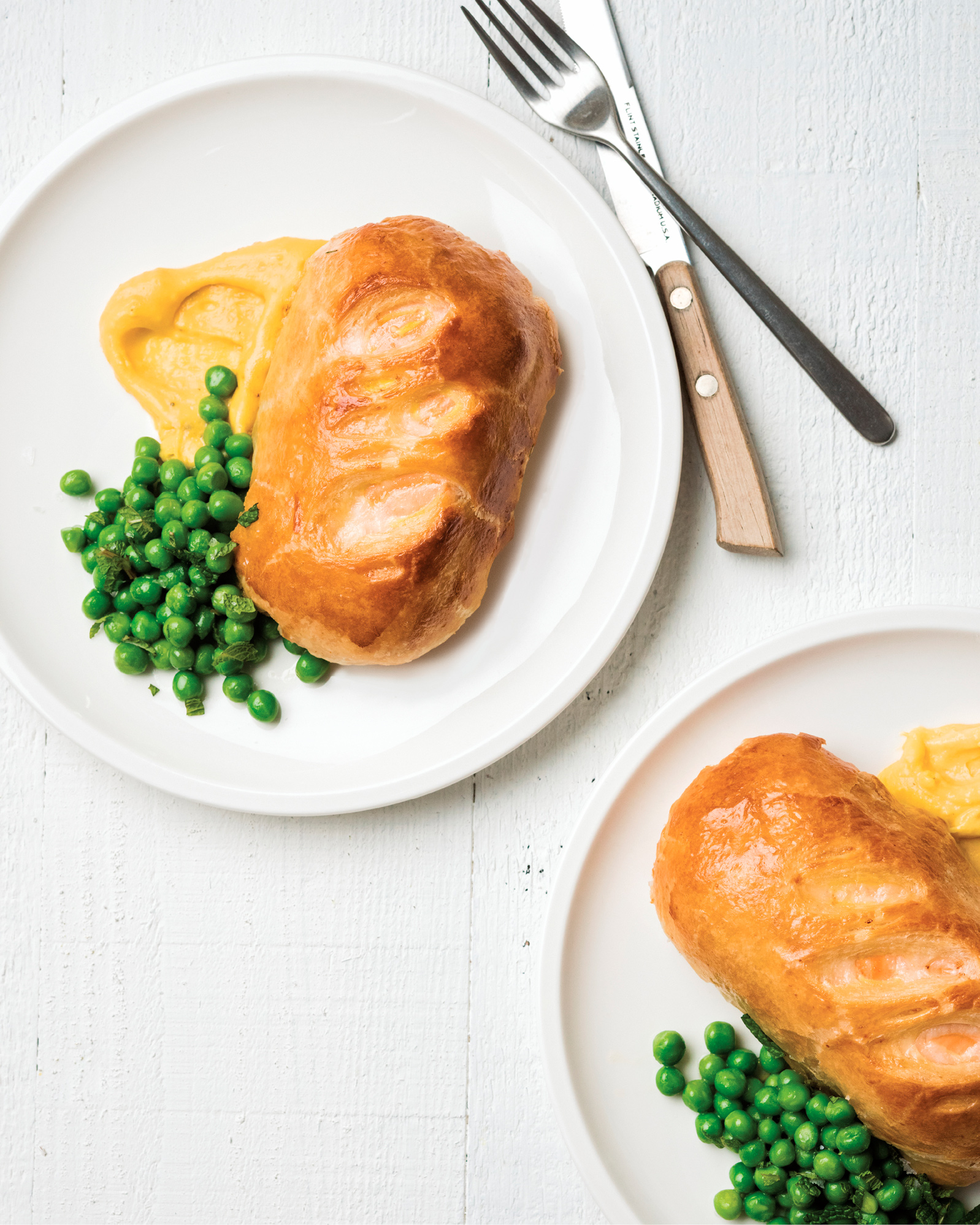

En croute refers to wrapping a fillet of fish in puff pastry. Sealed safely inside, the fish stays succulent as it steams in its own juices, while the pastry bakes into a crisp, golden brown crust. Jimmy and Andrew enhanced the flavor of the salmon by “stuffing” it with an herb-flecked butter and grainy mustard. They chose basil and dill, but you can really use any combination of fresh herbs. If you’re looking for a side to complement this dish, try the Roasted Potatoes (this page).
serves 4
Hollandaise
½ cup white wine vinegar
1 shallot, minced
6 whole black peppercorns
½ cup fresh tarragon leaves
4 large egg yolks
½ cup clarified butter (see Tip, this page), melted
Kosher salt and freshly ground black pepper
Minted Peas
2 tablespoons unsalted butter
3 tablespoons thinly sliced fresh mint
2 cups green peas, blanched (see Tip, this page)
Kosher salt and freshly ground black pepper
Salmon en Croute
⅔ cup unsalted butter, at room temperature
¼ cup finely chopped fresh dill
¼ cup finely chopped fresh basil
2 tablespoons finely grated lemon zest
Kosher salt and freshly ground black pepper
4 skinless salmon fillets, about 4 ounces each
¼ cup whole-grain mustard
All-purpose flour
2 sheets frozen puff pastry, thawed
2 large eggs, beaten
TIP Butter is “clarified” when it is cooked until the water evaporates and the milk solids float to the surface. The solids are skimmed, leaving behind perfectly clear butter. In India and other parts of the world, making clarified butter (called ghee) involves cooking the butter long enough to caramelize the milk solids, and even after they are skimmed, their nutty flavor remains. You can buy ghee in Indian grocery stores or online. Regular clarified butter is easy to find online, too.
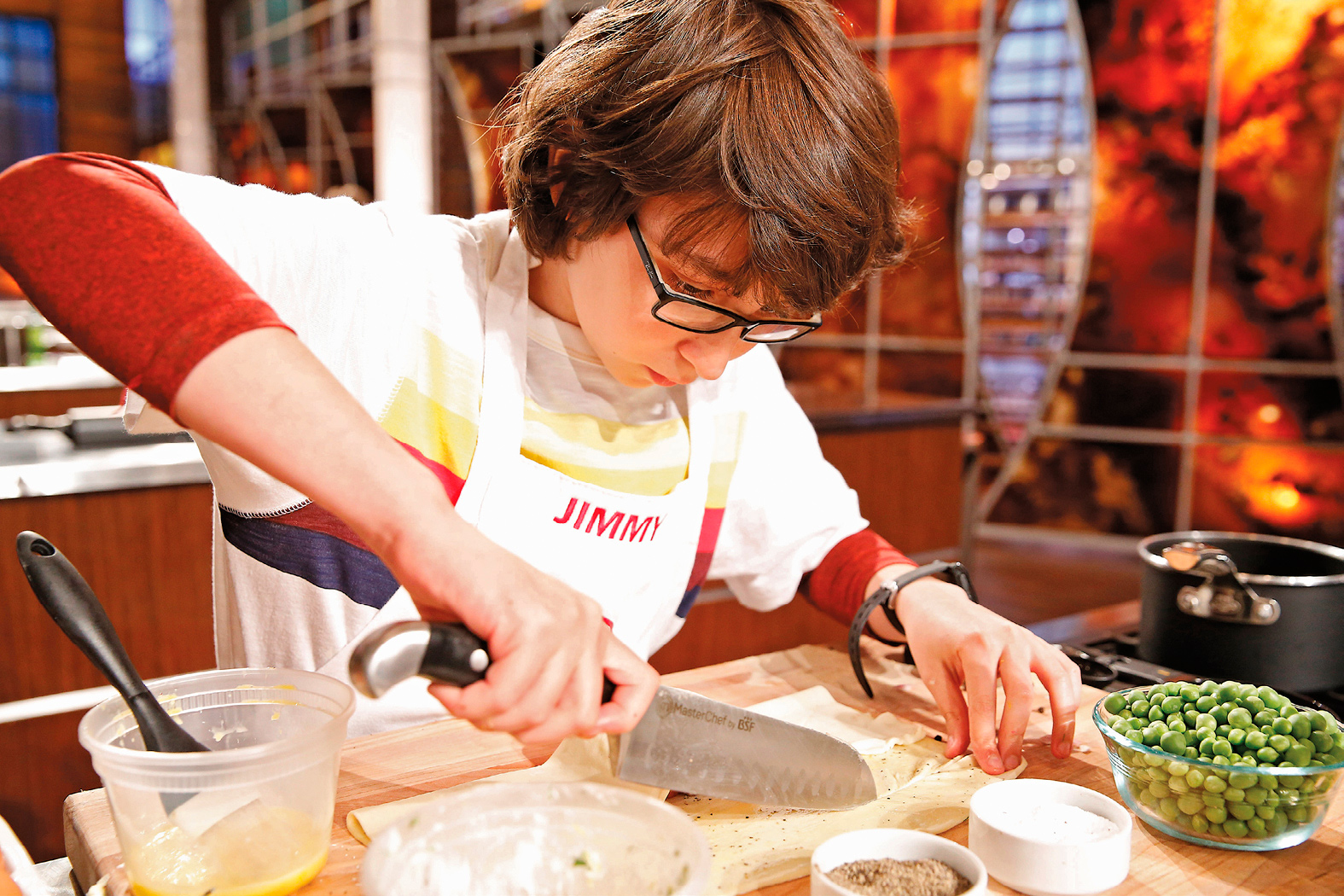
ARCTIC CHAR AND RICE NOODLES
in CURRY BROTH
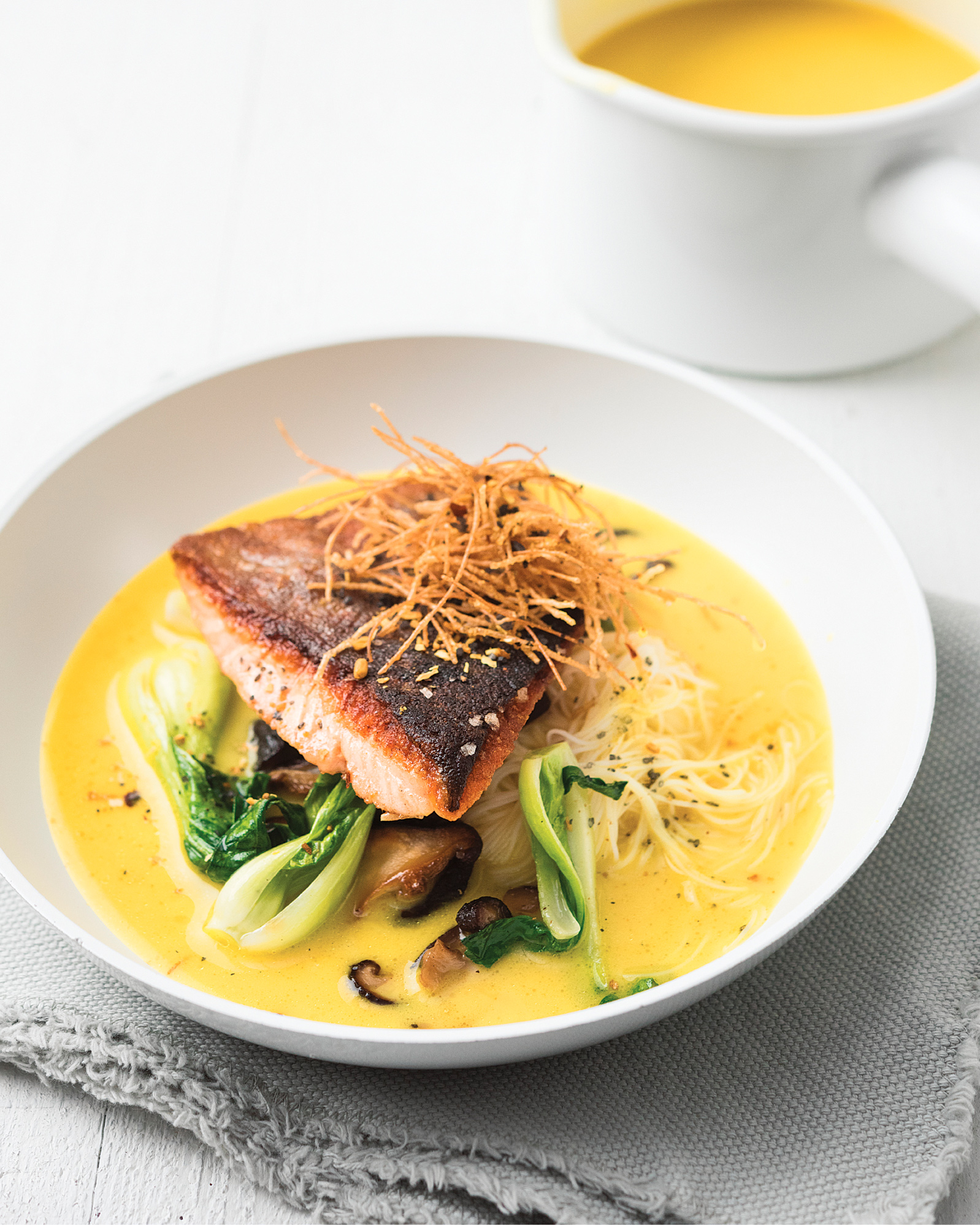

In the finale episode of Season 2, Samuel poured this curry broth into the serving bowl tableside, which heightened the drama and added to the presentation. Judge Joe Bastianich, recognizing that the fish is from the Arctic and the seasoning inspired by Southeast Asia, said, “I love the idea of taking two opposite parts of the world and putting them on the same plate.” All three judges agreed that Samuel had cooked the fish perfectly. “There are chefs in professional kitchens,” Gordon Ramsay said, “who overcook this fish time and time again, but you, young man, have absolutely nailed it. Well done!” With a little practice, you’ll be cooking arctic char like a pro, too!
serves 4
Curry Broth
2 cups seafood stock
2 (13.5-ounce) cans unsweetened coconut milk
1 (1-inch) piece fresh galangal, crushed (see Tip, this page)
1 (1-inch) piece fresh ginger, crushed
1 teaspoon ground turmeric
1 teaspoon coriander seeds, toasted (see Tip, this page)
1 tablespoon red curry powder
Pinch of saffron
1 stalk fresh lemongrass
1 tablespoon fish sauce
2 tablespoons fresh lime juice
Kosher salt
Arctic Char and Rice Noodles
Vegetable oil, for frying
8 ounces dried rice noodles
3 tablespoons vadouvan spice blend (see Tip, this page)
1 tablespoon Himalayan black salt
6 tablespoons grapeseed oil
1 cup sliced shiitake mushrooms
2 baby bok choy, quartered lengthwise
Kosher salt and freshly ground black pepper
4 skin-on arctic char fillets, about 4 ounces each
Micro cilantro, for garnish
TIP Toasting whole dried spices is a fantastic way to boost their flavor. Place the spices in a small, dry pan and cook over medium-high heat, stirring often, until very fragrant and lightly browned.
TIP Galangal is a root vegetable that’s closely related to ginger. Look for it in Asian grocery stores. If you can’t find it, experiment with ginger here, or find another Asian spice you love!
SALT-BAKED BRANZINO
and ROASTED BABY VEGETABLES


When Logan presented this whole fish baked in a salt crust, the first thing judge Joe Bastianich said was, “This is one of the most unusual entrées we have ever seen in the history of MasterChef Junior.” All the judges knew Logan had made a bold move, because by baking in a salt crust, Logan was unable to check the doneness of the branzino. He risked baking it too long and ending up with an oversalted, dried-out fish. But, if it worked, it would be incredibly delicious. (For more on salt baking, see this page.) It turned out that Logan had nailed it—the fish was perfect. Served with a delicious chimichurri sauce, this dish is a real showstopper, so be sure to serve the fish in the salt crust, and then break it open on the table to really impress your guests.
serves 2
Salt-Baked Branzino
2 tablespoons juniper berries
2 tablespoons Sichuan peppercorns
2 tablespoons fennel seeds
2 teaspoons fennel pollen
2 pounds kosher salt
4 large egg whites, beaten
1 whole branzino, gutted and scaled
5 sprigs fresh thyme
2 tablespoons unsalted butter, cut into cubes
1 Meyer lemon, sliced into rounds
Roasted Baby Vegetables
½ pound baby pebble potatoes, scrubbed
¼ pound baby carrots
¼ pound baby yellow pattypan squash
¼ pound baby zucchini
2 sprigs fresh thyme
2 tablespoons olive oil
Kosher salt and freshly ground black pepper
Chimichurri (this page), for serving (optional)
LOGAN’S SALT-BAKING TECHNIQUE
Salt-baking a whole fish is a completely daring and unusual feat that Logan was able to bravely pull off in the finale of Season 2. Funny enough, he learned the technique when he was nine or ten years old by watching a YouTube video of Gordon Ramsay—the very same Gordon Ramsay who is a judge on MasterChef Junior! In the video, Gordon demonstrates every step of the salt-baking process, from covering the fish with a salt crust to cracking it open at the table for an extra-grand plating. Logan was so inspired that he asked his mom to buy an affordable whole fish for him to try the technique on at home. His experiment worked! The texture of his first salt-baked fish was amazing and the flavor was perfect, even though the fish wasn’t a particularly prized or expensive type.
When Logan encountered branzino for the first time on the show, he decided to risk the challenges of salt-baking and give it a try. “I had never tasted branzino before,” he says, “but it was in the MasterChef pantry, so it had to be good.” Reflecting on that moment, Logan remembers feeling a little worried that the fish might need a lemon-butter sauce served alongside, just in case the fish was dry or lacking in flavor. In the end, he decided to leave off the lemon-butter sauce, letting the clean flavors of the fish speak for themselves. (Sometimes the hardest part of putting together a terrific dish is knowing the importance of restraint!) Logan’s salt-baked branzino turned out to be super moist and succulent, and the judges were all so impressed with his mastery of this complicated technique (among other skills) that they pronounced him the winner of Season 2!
MISO BLACK COD
in COCONUT-GINGER BROTH
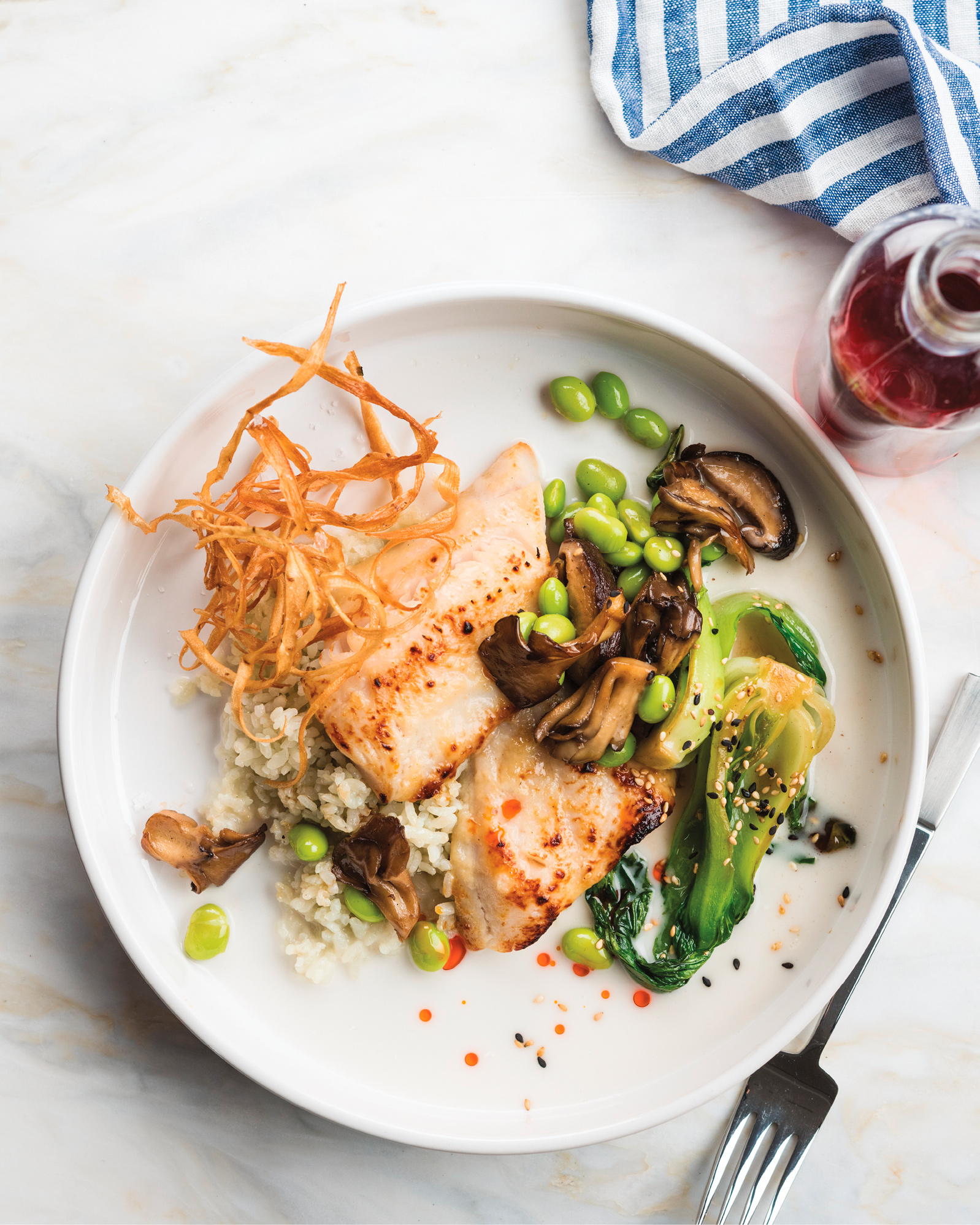

Complex and multilayered, this finale main course looks extraordinary, “like a spoonful of diamonds,” according to judge Gordon Ramsay. It also tastes remarkable. The judges called it “ridiculously good,” “fragrant, bright, and flavorful,” and “incredibly moist.” Judge Graham Elliot was most impressed by the fact that Addison hadn’t just blanched the bok choy, which is the most common way to cook the vegetable, but had sautéed it as well, creating nice caramelization. You could also use this technique on other dark leafy vegetables, such as kale, greens, and even Brussels sprouts!
serves 4
Cod and Broth
Vegetable oil, for frying
1 burdock root (see Tip, this page), peeled and thinly shaved using a vegetable peeler
Kosher salt
1 cup jade rice
3 tablespoons mirin
3 tablespoons sake
½ cup white miso paste
4 skinless black cod fillets, about 6 ounces each
1 stalk lemongrass
2 tablespoons grapeseed oil
2 tablespoons finely chopped shallot
1 garlic clove, minced
1 (1-inch) piece fresh ginger, peeled and coarsely chopped
2 makrut lime leaves (see Tip, this page)
2 cups chicken stock
2 cups unsweetened coconut milk
½ lime
Vegetables
6 tablespoons grapeseed oil
1 cup shiitake mushrooms, stemmed
1 cup maitake mushrooms (also called hen-of-the-woods)
¼ cup soy sauce
½ cup shelled fresh soybeans
4 baby bok choy, halved lengthwise
¼ cup oyster sauce
1 tablespoon black sesame seeds, toasted (see Tip, this page)
1 tablespoon white sesame seeds, toasted (see Tip, this page)
Hot chili oil, for garnish
TIP Makrut lime leaves are an important ingredient in Southeast Asian cuisine. They have an intense zesty aroma because they come from the makrut lime tree, a citrus fruit tree native to tropical Asia. You can buy them in Asian grocery stores—if you don’t see the fresh leaves near the vegetables and fruits, check the freezer section.
TIP Burdock is a slender root vegetable with a meaty texture, sort of like lotus root. Look for it in Asian grocery stores.
FISH TACOS WITH GUACAMOLE


The incredibly popular fish taco can be made hundreds of ways. But in the MasterChef Junior kitchen, you can be sure there will be a surprise twist. Sure enough, when Molly presented these during her audition, she garnished her fish tacos with one unexpected ingredient—pomegranate seeds! They are pops of delicious sweetness and look fantastic sprinkled over the fish. Best of all, Molly’s creativity reminds us to never stop experimenting and trying new things in the kitchen.
serves 4
1 pound Atlantic cod fillet, cut into 4 portions
3 tablespoons olive oil
Juice of 3½ limes, plus lime wedges for serving
2 ripe avocados, pitted and peeled
2 tablespoons minced onion
Vegetable oil, for frying
Kosher salt and freshly ground black pepper
1½ cups all-purpose flour
4 white corn tortillas, warmed
½ cup Mexican crema
½ cup shredded red cabbage
½ cup shredded green cabbage
¼ cup fresh cilantro leaves
¼ cup pomegranate seeds
VADOUVAN-SPICED MONKFISH
with PANCETTA LENTILS


Monkfish have distinctive scowling faces and large teeth! Don’t be fooled by their appearance, though, because fillets cut from their tail are firm, white, and delicious. Just be aware that monkfish is quite lean and can easily dry out if overcooked. Here, Jasmine paired the fish with salty pancetta, which actually appears twice in this dish.
serves 4
½ cup diced pancetta, plus 4 thin slices pancetta
2 medium shallots, finely chopped
2 tablespoons minced garlic
1 cup white wine
8 cups chicken stock
1¼ cups (2½ sticks) unsalted butter
Kosher salt and freshly ground black pepper
2 medium zucchini, very thinly sliced
1 pint cherry tomatoes, halved
2 cups lentils
Zest and juice of 1 lemon
2 tablespoons grapeseed oil
4 skinless monkfish fillets, about 6 ounces each
4 sprigs fresh thyme
3 tablespoons vadouvan spice blend (see Tip)
TIP Vadouvan is an Indian spice blend that typically includes dried onion and garlic, fenugreek, cumin, and mustard seeds.
“I started cooking when I was three or four. I was working with my mom in the kitchen making pancakes, and I spilled all the eggs I was mixing all over myself and the floor and started to get upset. My mom told me that it was okay and that we could just start again, and they turned out great. From that, I learned not to make a big deal out of a mistake, because cooking is just an experiment and you have to have fun with it.” —Jasmine
THAI PRAWN CURRY
with PRAWN DUMPLINGS

This rich yellow curry dish features prawns two ways. First, whole prawns (with their heads!) cook directly in the curry, infusing the sauce with their sweet, briny flavor. Second, dumplings filled with a mixture of prawns, chives, and cream are added to the curry just before serving. Judge Joe Bastianich congratulated Dara on cooking such a terrific, restaurant-quality dish, telling her, “I’d pay forty-five dollars for this!”
serves 4
1 (13.5-ounce) can unsweetened coconut milk
2 tablespoons chicken stock
¼ cup yellow curry paste
1 large carrot, thinly sliced
2 makrut lime leaves (see Tip, this page)
1½ teaspoons fish sauce
¼ cup Thai basil, leaves and stems separated
12 large prawns, head on
¼ cup heavy cream
1 tablespoon chopped fresh chives
1 (12-ounce) package wonton wrappers
½ cup snow peas, trimmed
4 ounces shimeji mushrooms (also known as beach mushrooms)
Kosher salt
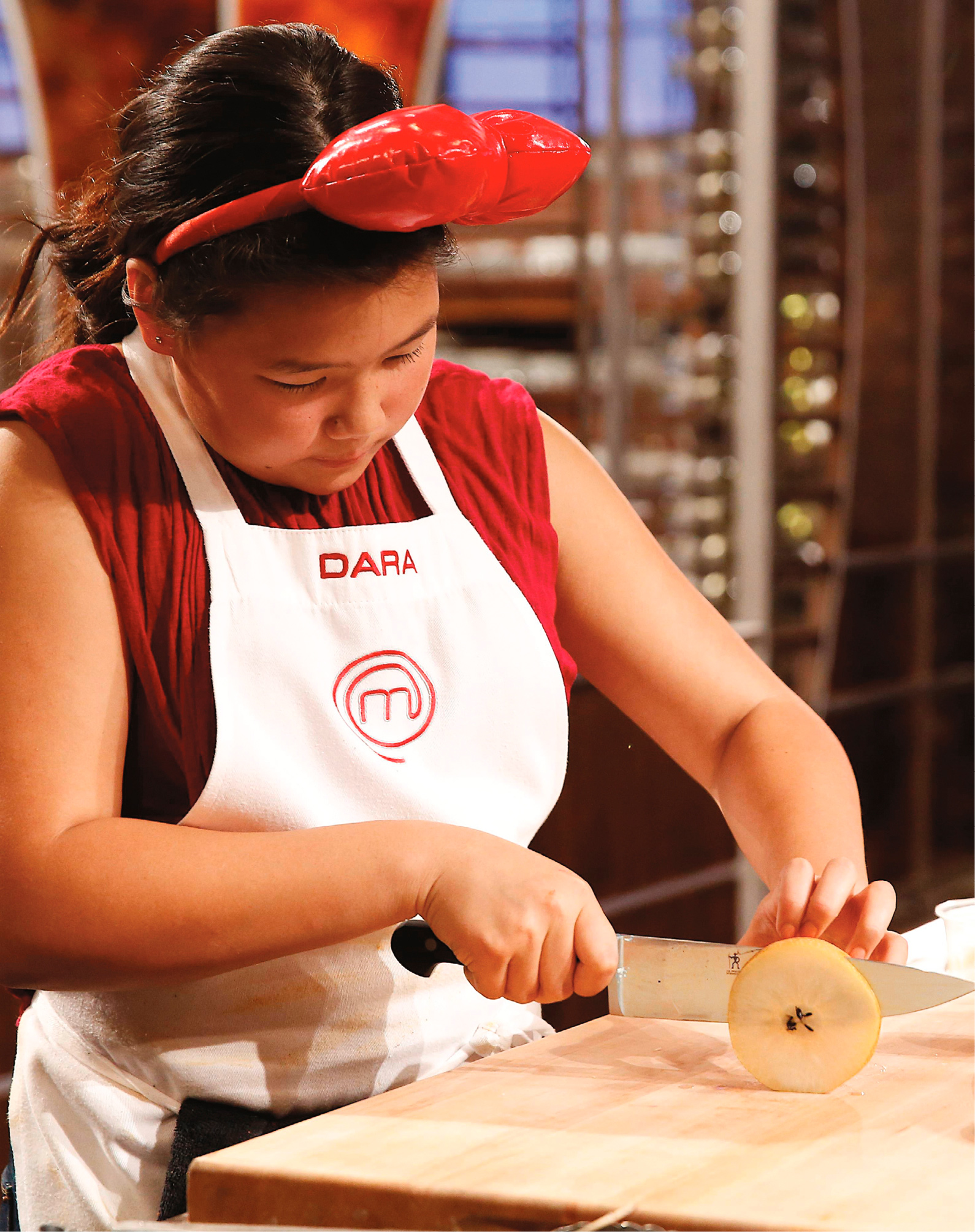
SOY-MARINATED YELLOWTAIL
with SAUTÉED GREEN BEANS and MUSHROOMS


Nate was so proud of the plating of this dish that he was presenting to the judges that he joked, “I think it looks great. I would probably marry it, if I had the chance!” It turned out that judge Christina Tosi loved the combination of Asian flavors going on here—the yellowtail’s soy marinade and the sweet-sour rice vinegar dressing on the Cucumber and Tomato Salad (this page), which Nate had arranged on the side. “This is the very best fish dish I’ve had in the MasterChef Junior kitchen,” she said.
serves 4
¼ cup soy sauce
½ cup rice vinegar
2 tablespoons sriracha sauce
1 tablespoon sesame seeds
1 tablespoon chopped fresh chives, plus more for garnish
4 yellowtail fillets, about 6 ounces each
Kosher salt
½ pound green beans, trimmed
2 tablespoons unsalted butter
6 tablespoons grapeseed oil
2 cups button mushrooms, chopped
Freshly ground black pepper
FOUR WAYS TO COOK FISH PERFECTLY
MasterChef Junior contestants are no strangers to making fish! And the range of techniques they’ve mastered is impressive. They fry, sear, broil, and even wrap in puff pastry and then bake fish of all kinds. When you’re preparing it at home, make sure to start with pristinely fresh fish—it should smell salty and clean, like the ocean. The type of fish matters less than its freshness. For example, salmon would be a fine substitute for arctic char, and any white, firm-fleshed fish could stand in for black cod. If you aren’t sure about a specific substitution, ask your fishmonger for his or her recommendation. And, as for what to do with fresh fish, here are four techniques for cooking fish fillets perfectly every time:
1)Broil: Preheat the broiler to high. After seasoning the fillets, place them skin-side down on a baking sheet and broil until just barely opaque all the way through, 7 to 10 minutes. Discard the skin before serving.
2)Poach in Olive Oil: In a large sauté pan with at least 3-inch-high sides, warm 1 quart olive oil over low heat until the oil registers 120°F on an instant-read thermometer. Cut 1 lemon into thin slices and add to the oil while it heats up. Season 4 fish fillets (each about 4 ounces) with salt and pepper on both sides. Carefully add the fish to the warm oil, making sure the fillets are completely submerged. (If they are not, add more oil as needed.) Poach for 10 minutes. Transfer the fish to a wire rack and allow the excess oil to drip off for a few minutes.
3)Pan Sear: In a large nonstick pan, heat 2 tablespoons grapeseed oil over high heat. Season the fillets with salt and pepper on both sides. Add the fish to the pan, skin-side down, and cook until the skin is golden brown and crisp, 2 to 4 minutes. Flip and cook on the second side just until the fish is barely cooked through, 2 to 4 minutes.
4)Fry: Pour at least 2 inches of vegeta-ble oil into a heavy-bottomed pot and heat the oil to 350°F. Pat the fillets dry and season with salt and pepper on all sides. Dredge the fish in all-purpose flour (or try different kinds of breading for the crust, such as cornmeal or finely ground saltine crackers), shaking off any excess. Carefully lower the floured fish into the hot oil and fry until golden brown, about 5 minutes. Transfer to a paper towel–lined plate and let cool slightly before serving.
And here’s a bonus! For a fifth showstopping way to cook fish, see Logan’s technique for salt-baking a whole fish on this page. Although he used branzino, this amazing trick would also work really well with other whole, scaled, and gutted medium-size fishes, like orata and red snapper.
CRAWFISH ÉTOUFFÉE

A true Louisiana girl at heart, Avery grew up on étouffée. This thickened seafood stew from the Cajun and Creole cuisines of Louisiana is nearly the definition of comfort food: warm, packed with flavor, and incredibly satisfying. It can be made with any type of shellfish, but Avery chose to make her version with the most traditional ingredient—crayfish, which people in Louisiana call crawfish. Feel free to put your own spin on this dish by using your favorite type of shellfish, or a combination of shrimp, crab, scallops, and clams, adding up to a total of one pound.
serves 4
Kosher salt
1½ cups long-grain white rice
¼ cup all-purpose flour
4 tablespoons (½ stick) unsalted butter
1 cup finely chopped onion
½ cup chopped celery
½ cup chopped green bell pepper
1 pound crawfish tail meat
1 teaspoon minced garlic
¼ teaspoon cayenne
1 bay leaf
Freshly ground black pepper
¼ cup thinly sliced scallions, white and light green parts
2 tablespoons chopped fresh flat-leaf parsley
SEARED SCALLOPS
with JALAPEÑO-POBLANO SALSA


With a stunning combination of green, yellow, and white ingredients, this dish looks as impressive as it tastes. The scallops are great on their own, but if you’re serving them over the Lemon Risotto (this page), as Tae-Ho did in Season 4, you’ll need to make it before searing the scallops. The smoky and slightly spicy jalapeño-poblano salsa can also be made ahead of time. Other great dishes to serve with the scallops are Broccoli Rabe Purée (this page) or Grilled Corn Succotash (this page).
serves 4
Jalapeño-Poblano Salsa
2 jalapeños
1 poblano pepper
½ red onion, chopped
2 garlic cloves
1 cup fresh cilantro
½ cup rice vinegar
1 teaspoon ground coriander
3 tablespoons olive oil
Juice of 1 lemon
Kosher salt
6 large Brussels sprouts
2 tablespoons olive oil
12 large scallops
Kosher salt and freshly ground black pepper
2 tablespoons grapeseed oil
1 red, golden, or candy cane beet
Lemon Risotto (this page; optional)
ALLIGATOR STIR-FRY
with GRILLED PINEAPPLE

When cooking alligator meat, follow Cory’s lead and use lots of different spices to create a bold dish with a touch of heat. Including grilled pineapple is a brilliant way to balance the spiciness with sweetness. Although alligator meat is common in the South, it’s not as easy to find in other parts of the country; look for it in specialty markets or buy it online.
serves 4
½ small pineapple, peeled and cut into rounds
5 tablespoons grapeseed oil, plus more for brushing
1 pound alligator meat, finely chopped
Kosher salt and freshly ground black pepper
1 tablespoon toasted sesame oil
½ cup chopped carrot
1 cup chopped onion
2 cups coarsely chopped broccoli
1 cup fresh corn kernels
½ jalapeño, finely chopped
3 black garlic cloves (see Tip), minced
½ teaspoon Chinese five-spice powder
¼ teaspoon freshly grated nutmeg
¼ cup soy sauce
1 tablespoon fish sauce
1 teaspoon black sesame seeds
4 large eggs
Steamed rice, made without rose water (see this page)
TIP Black garlic, an ingredient used in Asian cuisines, gets its dark color from a weeks-long cooking process. It tastes syrupy and sweet, sort of like balsamic vinegar. Look for it in Asian grocery stores.
SEAFOOD AND RAINBOW CHARD
in SHELLFISH BROTH
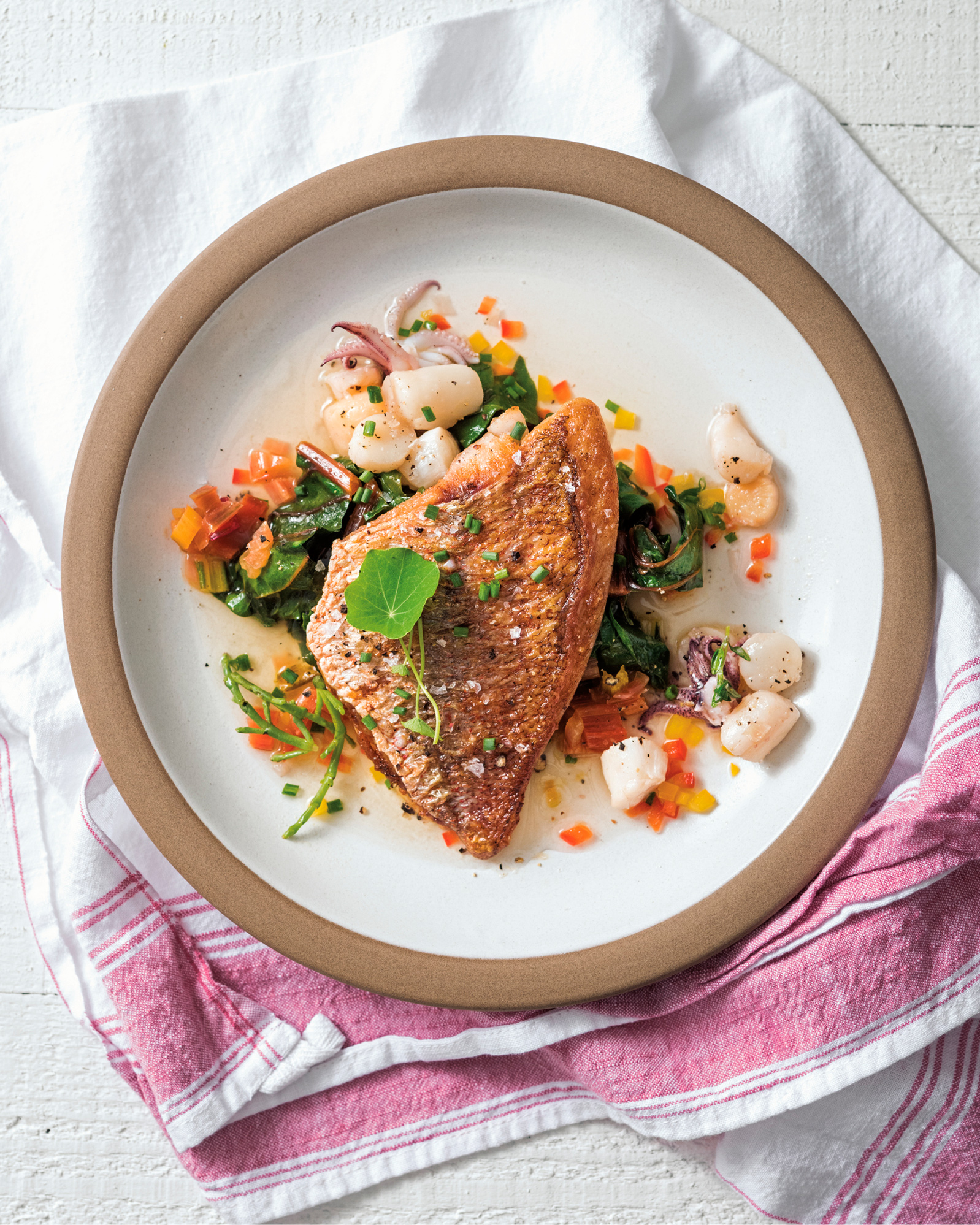

Like jewels on display, a stunningly beautiful collection of seafood comes together in this elegant dish. Calamari tentacles, baby scallops the size of silver dollars, and thin slices of razor clam surround a seared red snapper fillet, and a flavorful shellfish broth poured over everything ties together these many flavors of the sea. You could certainly use any combination of fresh seafood that you prefer, but keep in mind that a mixture of textures—tender, chewy, and flaky—is ideal.
serves 4
Rainbow Chard
Kosher salt
1 large bunch rainbow chard
2 tablespoons grapeseed oil
2 tablespoons unsalted butter
1 tablespoon finely chopped shallot
1 tablespoon minced garlic
Freshly ground black pepper
Seafood
4 skin-on red snapper fillets, about 4 ounces each
Kosher salt and freshly ground black pepper
6 tablespoons grapeseed oil
20 small calamari tentacles
20 baby scallops
4 razor clams, cleaned and cut into ¼-inch slices
4 sprigs fresh thyme
1 tablespoon finely chopped shallot
1 tablespoon minced garlic
½ cup white wine
1 lemon, quartered
Shellfish Broth
1 cup shellfish stock
¼ cup extra-virgin olive oil
¼ cup finely chopped red bell pepper
¼ cup finely chopped yellow bell pepper
2 tablespoons chopped fresh chives
Kosher salt
8 (1-inch-long) pieces sea bean (see Tip, this page)
20 fresh nasturtium leaves (see Tip, this page)
¼ cup chopped fresh chives
TIP Nasturtium leaves come from the beautiful plant of the same name with sunny yellow-orange flowers. You may have seen it growing in your neighborhood—it’s one of the most popular garden plants! The leaves and flower petals are edible and have a terrific peppery taste, sort of like arugula or watercress. You can also buy nasturtium leaves at some grocery stores.
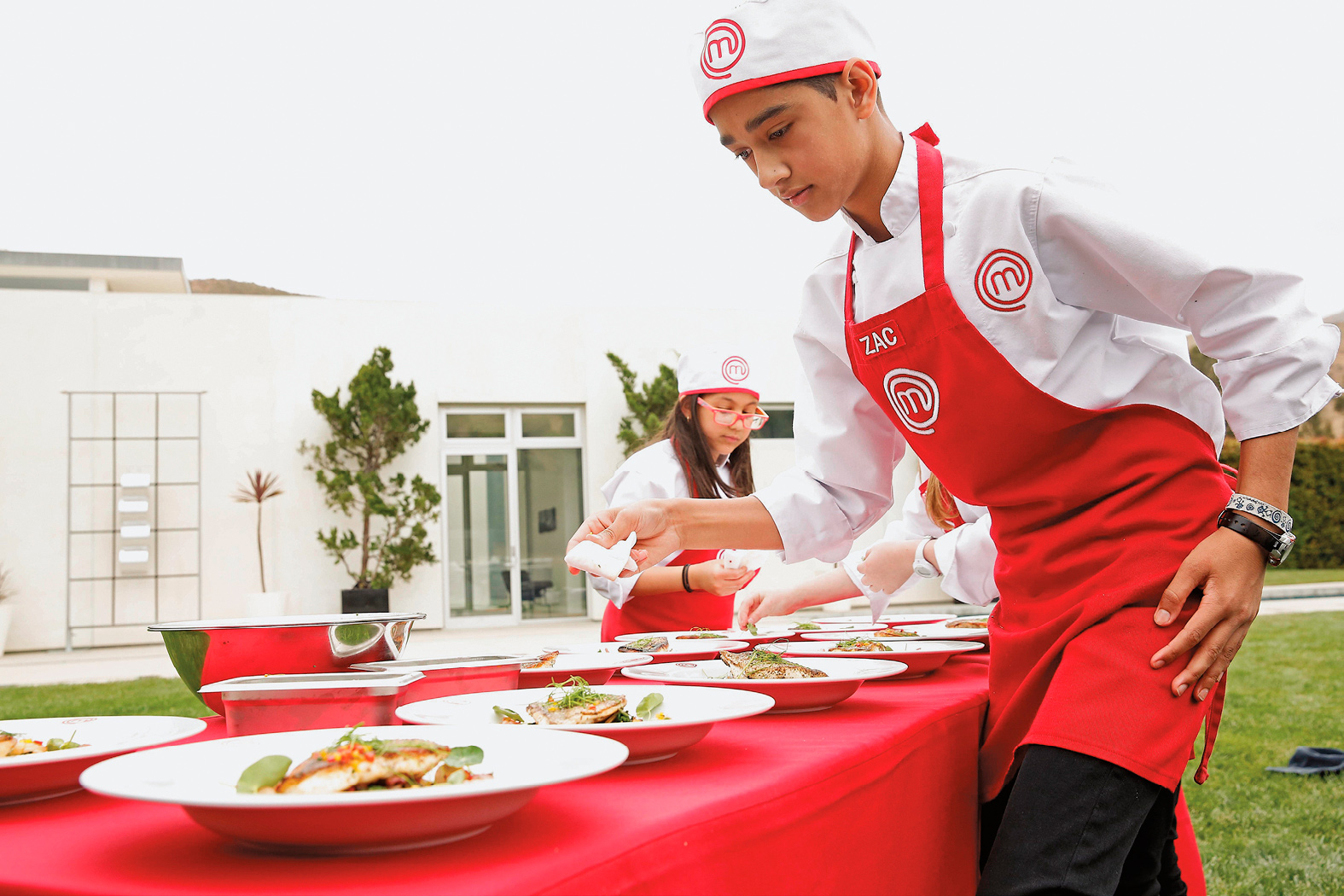
WEST INDIAN LOBSTER CURRY
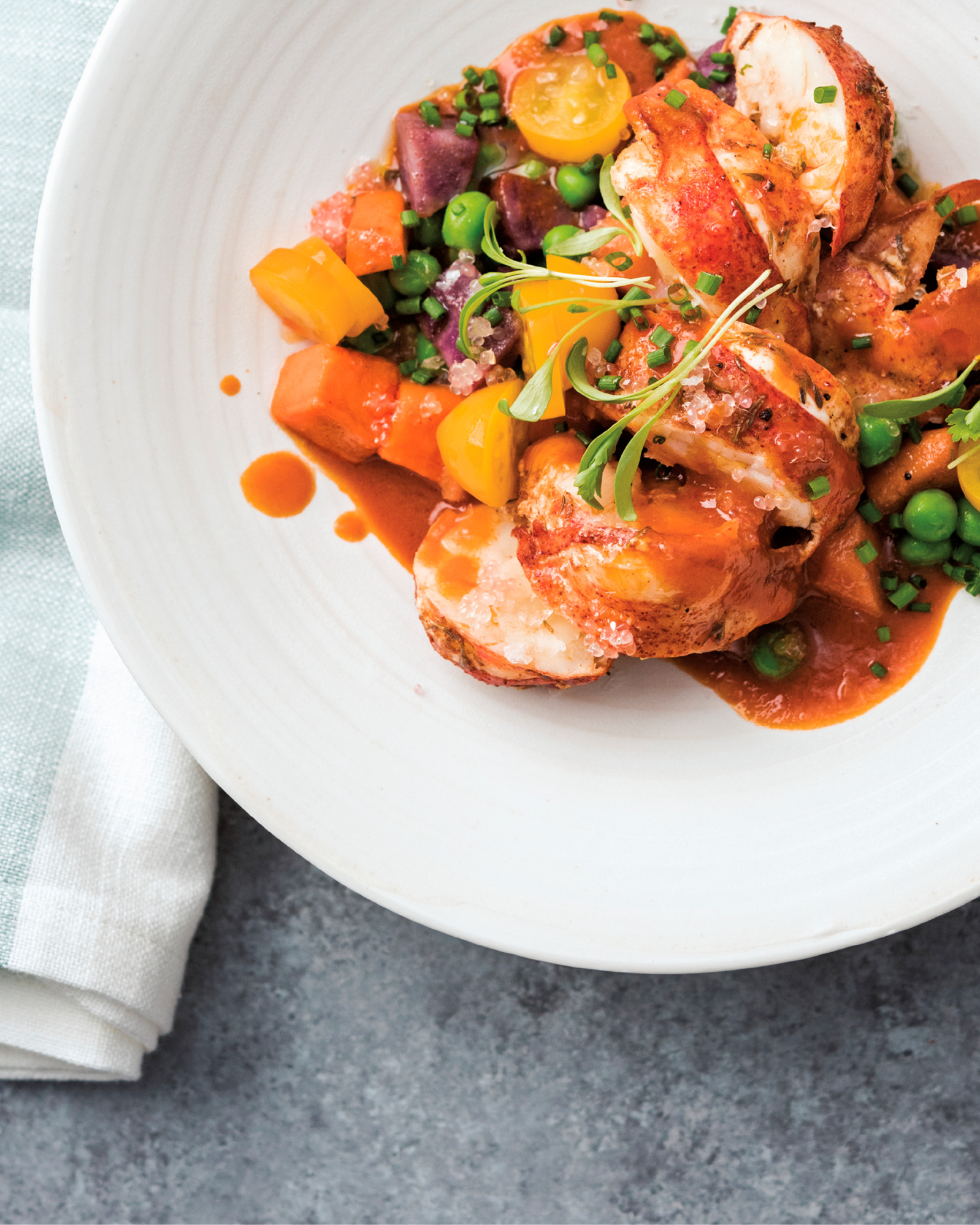

In her version of West Indian curry, Jasmine honors tradition by including some of the classic flavors of the Caribbean: chile, cilantro, pepper, and citrus. At the same time, she makes it uniquely hers in many ways, including garnishing with finger lime, a tiny citrus relative native to Australia. Finger limes are filled with caviar-shaped bubbles of zesty juice, and they add fun pops of flavor to this stunning dish.
serves 4
Curry Sauce
1 tablespoon grapeseed oil
1 red bell pepper, chopped
1 green bell pepper, chopped
2 celery stalks, chopped
1 small yellow onion, chopped
½ serrano chile, sliced
3 tablespoons tomato paste
2 tablespoons red curry powder
2 tablespoons white rum
2 (5.5-ounce) cans mixed vegetable juice, such as V8
2 cups unsweetened coconut milk
1 quart seafood or shellfish stock
Juice of 2 key limes
6 sprigs fresh cilantro
2 tablespoons unsalted butter
Lobster
Kosher salt
4 lobster tails, shell on
1 cup (2 sticks) unsalted butter
1 tablespoon jerk seasoning
2 garlic cloves, crushed
Vegetables
2 orange sweet potatoes, peeled and diced
2 purple sweet potatoes, peeled and diced
1 cup shelled English peas
2 tablespoons unsalted butter
1 tablespoon dark brown sugar
Kosher salt
8 yellow cherry tomatoes
2 tablespoons chili oil
4 finger limes, rinds removed
¼ cup chopped fresh chives
¼ cup micro cilantro
“What inspires me in the kitchen is the quest to make things out of what I have in my pantry and to make them delicious and something that represents me—sweet, Southern, savory, and Caribbean. Once I’ve done that, I know my meal is going to be great. And it’s incredibly fun!” —Jasmine

